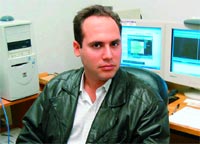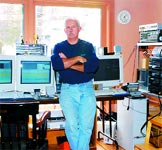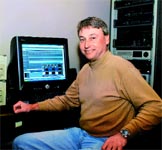From urban apartments to country homes, on desktops and laptops, video and audio editors are enjoying life as guerrilla independents thanks to systems that are fast, efficient and incredibly full featured.
APARTMENT EDIT SUITE FOR 'FRIDA' DOC
After a distinguished documentary career during which post production meant sitting at a Steenbeck, Amy Stechler is cutting her new project The Life and Times of Frida Kahlo on Apple's Final Cut Pro 4.1. Stechler was co-producer, writer and editor of the acclaimed The Shakers: Hands to Work, Hearts to God and writer and editor of Brooklyn Bridge.
Although she had used FCP to edit family videos, Stechler had never cut professionally on a computer until now. Before committing to the Apple software she did a lot of research and asked a lot of questions. The Life and Times of Frida Kahlo, co-produced by Maia Harris and Victor Zamudio-Taylor, was shot in HD, and Stechler needs to deliver an HD master to PBS. It will air the documentary this fall.
"Cost was a big consideration in choosing an edit system," she says. "Final Cut was getting more serious so I talked to rental houses and editors I knew and decided to take a chance with it. But the question of getting out of Final Cut and back to the HD suite [for finishing] still makes me nervous."
Freelance technical supervisor Michael Yecies was confident about FCP's HD finishing compatibility and helped Stechler configure the editing system in the Daylight Films office www.daylightfilms.org/ in her Brooklyn home. She cuts on an Apple G4 dual processor with three extra hard drives for a total of 800 gigs of storage. Her system features a pair of large Apple screens, a smaller TV monitor and a Sony DSR VTR; the documentary's HD footage has been downconverted to the DVCAM format for offline.
With her extensive film background Stechler says she's "the last person who should be pioneering in technology." But she's a pioneer not only in FCP HD finishing but also in her unusual HD acquisition choice. "We were able to get gorgeous controlled interview footage with the Sony F900 at 30p," she reveals. "People shoot 24p HD because of the 24-frame film thing or 30i because that's the camera's native format. But shooting interlaced gives an ultra-crisp look to the image. Progressive gives a much softer look, and 30p is a perfect in-between solution. I have no regrets about not shooting on film."
About three quarters of Stechler's material consists of digital files of still photos, which will be rendered out and inserted into the timeline. "Right now my big challenge is moving on the photos, drifting in or panning across them," Stechler reports. "Our post supervisor Julia Mintz has done a lot of tests for this. The Final Cut software's only weakness is in this area, and After Effects is jittery and not very stable with HD. I'm using Stage Tools' Moving Pictures to simulate the moves in offline, and we've decided to use [Quantel's] iQ in the online for beautiful, seamless moves." At press time, she was still investigating where to go for iQ services.

Ari Grief cut his film 681-0638 on a Matrox/Premiere 6.5 set-up in his home.
|
Stechler is enjoying her newfound guerrilla independence. "I've had nine months to cut this documentary," she says. "I couldn't have afforded that if I were renting an Avid room."
BEST OF BOTH WORLDS
Like Amy Stechler, Ari Grief of Griefilm www.griefilm.com/, a Toronto production company he founded in 1999, also transitioned from a Steenbeck to nonlinear editing. The writer/director/producer learned to edit in film school and now has a home studio featuring a homemade Pentium Intel 4-chip, PC-based Matrox RTX100 system with three hard drives and a 19-inch monitor. It runs Adobe Premiere 6.5 software. Sometimes he also uses a colleague's home editing room, which boasts "more gear," but Grief hasn't needed to buy time at offline facilities. "Everyone I know has a system," he says, "because these tools have become so much more accessible. Making a film is somewhat less daunting than it used to be. You can try things, experiment without wasting money."
Grief believes his traditional film editing background gives him a bit of an edge as a cutter. "A lot of working editors were trained on the computer; they're not aware of film editing as a concept, and I think that takes away some of the skill aspect required of film editors. I'm happy I learned to edit on the Steenbeck. I've been able to apply the idea of editing by the frame to my Matrox system. It's the best of both worlds."
Grief's editing system has allowed him do for-hire work for clients while trying to "ignite" his feature film career. "My corporate work is financing my creative feature aspirations," he says. Grief has already completed his first motion picture, which he cut on the Matrox/Premiere system. Called 681-0638 the thriller is a Jim Jarmusch-style look at the people who use a New York City pay phone over the course of a day. "I made it as a calling card for my next feature," Grief explains, "but I'm also looking for a distributor."
Grief recently wrote, produced, directed and edited a 10-minute Star Trek spoof for a multinational eye care company's sales meeting. It included "Beam me up, Scotty" effects accomplished via dissolves, granular effects and color changes. "Matrox and Premiere are an excellent package," Grief reports. "By working quickly and less expensively, but at a high quality, I'm able to compete with larger studios while giving more personal attention to clients."
Grief is considering going more guerrilla with a laptop editing system. When he couldn't find nearby editing facilities in the Rocky Mountain resort of Banff, where he needed to cut material for an on-site presentation, he configured a Toshiba P20 Satellite laptop with 17-inch widescreen monitor with a Pentium 4 3.2 gigabyte double-threaded chip, video card and Premiere software. "I edited in the hotel room, and my client was impressed," he recalls. "A system that mimics my desktop on a laptop, that would enable me to go anywhere and edit on the fly, might be my next investment. With wireless communications you could have your own communications center floating around with you."

1 Beyond user Tim Morse works in a 3,400-square-foot building on his property just outside of Boston.
|
A 20-year television veteran, Wes Morgan vividly remembers telling people "you'll never be able to edit on a computer." Then came NewTek's Video Toaster and Morgan's quick realization of what was to come. He set himself up with a DPS Personal Animation Recorder and Toaster rendering to a hard drive, stayed abreast with DPS Perception, then migrated to Velocity.
Morgan heads Morgan Multimedia (334-791-0295) in Dothan, AL, and also serves as coordinator of educational technology at Troy State University in town. His bucolic home office, which overlooks a lake, boasts DPS Velocity 8.2 which came bundled with DFX+ and Sound Forge, and is networked to Adobe Photoshop, NewTek LightWave 3D and the extremely useful Digital Juice library of animated backgrounds, alpha channels and lower thirds.
A longtime DPS customer, Morgan calls the company "user friendly" and says Velocity has been "very dependable" over the years. "That's very important to me. It's nice to know that when you promise a client something will be out the door, you can count on Velocity."
Morgan, who specializes in programming and promos for sports and the outdoors, often has quick - even last-minute - deadlines for projects. His software repertoire came in handy when longtime client the Bass Anglers Sportsmen's Society (B.A.S.S.) needed a sophisticated, high-energy promo for an upcoming event. He turned it around in a day-and-a-half tapping his archive for clips from previous events, sourced backgrounds in Digital Juice, composited elements in DFX+, tweaked the B.A.S.S. logo in Photoshop and used Sound Forge for audio sweetening and mixing. "The only thing I needed was the voiceover, which came in on MP3," Morgan recalls.
Morgan shoots and handles location production for the Outdoor Channel series People Who Fish, which he also packages for air. By tabbing the 13-week series to a timeline, he's able to insert, with just a few keystrokes, edited segments for new episodes between commercial breaks, opens and closes, bumpers and other graphics he's created. When the EQ on mics in the field is muddy, Morgan can go back into the timeline, copy audio attributes from previous shows and apply them to the new segments for automatic clean up. "The ability to go back and forth within timelines and grab elements, effects or filters is an extreme time saver," he reports.
LARGE VENUE PROJECTS, SMALL SHOP
Hollywood-based independent Discreet Flame artist Lyle Eckmeier (323-462-3098) may be more itinerant than guerrilla-like due to the nature of his tool set. "I have a home studio, but a lot of my efforts are fairly ambitious and require equipment and support," he notes. "In the last few years I've four-walled a suite or rented a system and installed a set-up on a project-by-project basis. It's a neat time to do this: The tools are at a point where so much is possible for a person outside the structure of a facility."
A good deal of Eckmeier's work is content for large-venue video installations for theatrical, theme parks, museums and trade shows. He typically hires a core team of freelancers to help him with these projects.
For a five-source, 26-screen, all-HD, graphics-intensive video for the Epson booth at the Consumer Electronics Show earlier this year, Eckmeier was able to rent the HD Flame suite at L3 Digital in Burbank while the company was closed for the holidays. "We had a two-week turnaround for our part," he recalls. "We brought in a couple of our own G5s, running [Discreet] Combustion and After Effects, and networked them with the Flame."
Eckmeier notes that "with HD and myriad screens there's so much content that throughput on workstations can be an issue. Flame adds several years to my lifespan with its speed and efficiency, especially in compositing and color correcting these kinds of projects." The multisource Epson project was conformed at Toluca Lake's Post Solutions in an HD linear edit suite and 5.1 surround Digidesign Pro Tools room. Five hour-long HD streams required extensive round-the-clock technical support and flexibility from Post Solutions.
A Disney video installation, designed to be integrated with a live show at the California Adventure Theme Park, found Eckmeier renting two Flames over the life of the six-month project. The show, designed for display on a three-source 60-by-20-foot fixed overhead curved screen and a stage-centered dynamic screen, required Eckmeier to respond to massive changes in the live production just before final delivery. "With the team, infrastructure and tools we had, we could deal with it," he states.
Teaming with post boutiques such as L3 Digital and Post Solutions as "a low-impact client" is a model that's worked well for Eckmeier. "It's a much more relationship-based way of doing business than working with larger, more factory-like facilities," he says. "It enables me to create a more flexible work environment adaptable to each project.."
A still photographer for 20 years before he switched to video production and post in 1996, Tim Morse is a longtime resident of Carlisle, MA, a woodsy community 25 miles from Boston where "cottage industry flourishes," he reports. He has established Morse Video, a division of Morse Photography www.morsephotography.com/, in a cathedral-ceilinged 3,400-square-foot building on his property which boasts a full Pro Tools recording studio, photography/video studio, video editing suite with two 1 Beyond systems and a client meeting room complete with eat-in area and hot tub.
While Morse's professional lifestyle may sound more luxurious than guerrilla, he's no stranger to a 100-hour work-week, specializing in projects for not-for-profits and producing a Holocaust-themed documentary in collaboration with filmmaker Federico Muchnik.
Morse invested in his first 1 Beyond editor in 1998 when a video equipment vendor urged him to take a look at the system developed by Terry Cullen in nearby Somerville; a second system soon followed. 1 Beyond delivers turnkey video systems that provide quality digital workflow in DV, SD and full 10-bit uncompressed HD. They may be configured as laptops, desktops, mobile and rack-mounted systems.
Morse uses a dual-monitor system for larger projects and the second system for smaller projects and DVD authoring. The 1 Beyond editors have Canopus DV Storm as the underlying program for Premiere 6.5. He also runs After Effects and Photoshop on his PCs, as well as Photoshop on a Macintosh for more serious still photo needs.
"1 Beyond appealed to me as a turnkey system; I'm a driver, not a mechanic," says Morse. "The system is easy to use and intuitive. I started with a non-realtime system and now more than 90 percent of what I do is realtime. Terry has created a system that optimizes the software and hardware available today, and he offers great technical support."

Wes Morgan, pictured with his DPS Velocity 8.2, works out of his home. He cut this promo spot for the Bass Anglers Sportsmen's Society.
|
Morse's client list includes Boston's prestigious Wang Center for the Performing Arts, Wheaton College, Harvard University and New England Sinai Hospital. An 18-month project for MIT's Lincoln Laboratory marked the institution's 50th anniversary.
He and Federico Muchnik are currently working on a feature-length documentary, Secret Courage: The Walter Suskind Story, which had its roots in a profile of philanthropist and Holocaust survivor Dr. Maurice Vanderpol for the Wang Center. Vanderpol and his wife Netty were interested in recognizing and commemorating Suskind who, working with Dutch Resistance groups, saved nearly 1,000 Jewish children and several thousand adults from deportation to Nazi death camps. The filmmakers are seeking funding for completion of the documentary and are looking for PBS, cable or theatrical distribution.
TWO GUYS, '33 ACRES'
Filmmakers Luke Meyer and Branch Rothschild, whose company is called Of Seven Thousand www.ofseventhousand.250free.com/, are presently in post on the documentary 33 Acres, about the conversion of a neighborhood in the Maplewood municipality of St. Louis to a mammoth Wal-Mart shopping center. They shot the documentary on DV last year and will continue adding new footage through next fall.
"The story was unfolding as we shot last summer," says Meyer. "We've been playing with a couple of outlines; there's a certain chronology to get across, and we need to develop characters so viewers can relate to and care about the people they're watching."
Meyer and Rothschild have set up an Avid Xpress Pro edit suite in a portion of their St. Louis apartment. The software runs on a laptop and they have several external drives. At press time the filmmakers had begun digitizing footage and were to start intercutting extensive interview footage with clips of demolition and construction.
"I've found Avid software to be the least problematic and most intuitive editing software I've tried," Meyer says. "Xpress DV and Xpress Pro are designed to handle DV footage, which is ideal for us. It's amazing how, with the introduction of DV, editing software can be used on laptops. Ease of use doesn't even begin to describe it compared to how things used to work. We can edit a small series of clips without the external drives in a coffee shop, a library, wherever we need to be. Everything is possible." Meyer acknowledges that "this project probably wouldn't be happening if not for the technology" which permits him and Rothschild to work inexpensively but at a high quality at the same time. "If we had to rent an edit suite, we couldn't do it," he observes.